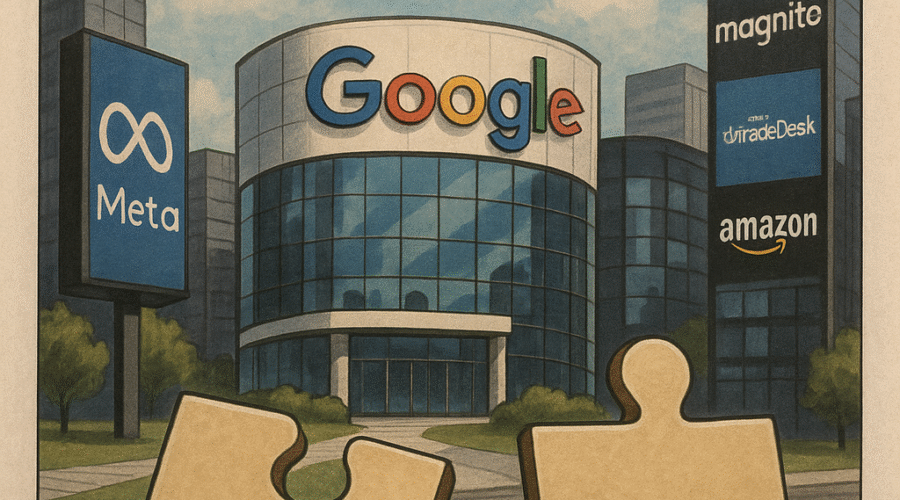In a landmark antitrust ruling with far-reaching consequences for the digital advertising ecosystem, U.S. District Judge Leonie Brinkema has set the stage for potentially dismantling Google’s $95 billion ad technology empire. The April 2025 decision found Alphabet’s subsidiary guilty of “willfully acquiring and maintaining monopoly power” through its integration of DoubleClick for Publishers (DFP) and Ad Exchange (AdX), tools that control 90% of publisher ad servers and up to 89% of ad exchange markets[1][5][6]. With a remedies trial scheduled for September 22, 2025, the U.S. Department of Justice (DOJ) is pushing for structural separation of Google’s ad tech stack—a move that could redefine competition in the $720 billion global digital advertising industry while testing the limits of antitrust enforcement in the Big Tech era.
The Anatomy of Google’s Ad Tech Dominance
Market Control Through Vertical Integration
Google’s anticompetitive strategy centered on bundling DFP (its publisher ad server) with AdX (its programmatic exchange), creating what Judge Brinkema termed a “self-reinforcing cycle of dominance”[5]. This technological and contractual integration allowed Google to simultaneously represent both advertisers and publishers while controlling the infrastructure connecting them—a conflict of interest that suppressed header bidding alternatives and depressed ad prices by up to 40% according to DOJ estimates[2][6]. The court found that 96% of large publishers used DFP, while AdX processed 89.13% of all U.S. display ad transactions in 2024[6].
Financial Stakes and Ecosystem Impact
The targeted ad tech assets generate $95 billion annually—15% of Alphabet’s total revenue—through fees averaging 19-22% per transaction across the ad stack[2][6]. This revenue funds Google’s broader ecosystem, including Android, Chrome, and AI initiatives. A forced divestiture could immediately reduce Alphabet’s operating cash flow by $29 billion annually while creating pricing transparency that might lower advertiser costs by $12-18 billion industry-wide[6].
| Segment | Market Share | Key Competitors |
|---|---|---|
| Publisher Ad Servers | 90% | Amazon Publisher Services, OpenX |
| Ad Exchanges | 89.13% | Index Exchange, Magnite |
| Advertiser Networks (SMB) | 80% | Facebook Ads, The Trade Desk |
The DOJ’s Two-Phase Remediation Strategy
Immediate Behavioral Constraints
Phase one of the proposed remedy mandates real-time bid data sharing through Prebid systems, elimination of Unified Pricing Rules (UPR), and termination of “first-look” bidding advantages that gave Google’s exchange 150ms priority access to DFP inventory[2][6]. These measures aim to reduce latency for competing exchanges from 300ms to under 50ms, potentially increasing header bidding win rates by 27%[3][6].
Structural Separation Timeline
The DOJ’s breakup plan envisions spinning off DFP and AdX into a standalone entity by 2027, with strict prohibitions against data sharing or technical reintegration with Alphabet[6]. This mirrors the 1984 AT&T divestiture but introduces novel challenges given the interconnected nature of digital assets. Potential acquirers include private equity consortia, cloud providers (AWS, Azure), or a new entity governed by publisher consortiums like the News Media Alliance[5][6].
Google’s Defense and Industry Counterarguments
Alphabet contends that divestiture would “break core functionality” of its advertising products, citing potential 40% increases in ad load times and $7 billion in developer costs to decouple DFP/AdX APIs[6][8]. The company warns of reduced small publisher payouts (estimated 15-22% decline) and fragmentation risks in measurement tools like Google Analytics 4[6]. However, testimony from Index Exchange CEO Andrew Casale emphasized that proper safeguards could prevent reconsolidation while increasing publisher revenues through true auction competition[3][5].
The Global Precedent for Tech Regulation
This case represents the first simultaneous pursuit of structural remedies against a single company (Google) across multiple jurisdictions—the Eastern District of Virginia handling ad tech while the D.C. Circuit addresses search monopolization[5][7]. The DOJ’s approach draws from the Microsoft antitrust case but updates remedies for the platform economy era. Success could embolden parallel actions against Amazon’s AWS-commerce tie-ins and Meta’s social advertising dominance[4][7].
Projected Market Impacts Post-Divestiture
Publisher Economics
Independent analysts predict CPM increases of 18-25% for mid-sized publishers as competition reduces Google’s take rate from 19% to 12-15%[6]. The New York Times reported internal projections showing 30% faster header bidding adoption if DFP becomes neutral infrastructure[3].
Advertiser Implications
Brands could save $0.002-$0.005 per impression through multi-exchange auctions, translating to $4.7 billion annual savings for Fortune 500 companies[6]. However, increased fragmentation may raise attribution costs by 12-15% initially before new standards emerge[2].
Technology Ecosystem Shifts
A standalone DFP/AdX entity would likely accelerate adoption of seller-defined audiences (SDA) and encrypted signal sharing, reducing reliance on third-party cookies. Cloud providers like AWS are already developing alternative ad servers leveraging their CDN networks, with beta tests showing 50ms faster load times than DFP[6].
The Road Ahead: Legal and Operational Challenges
Judge Brinkema’s final ruling—expected by Q2 2026—will face immediate appeals to the 4th Circuit and potentially the Supreme Court. Alphabet has reserved $14 billion for legal costs through 2027 while exploring contingency plans like spinning off Google Cloud as a regulatory “safe harbor”[8]. Meanwhile, the EU’s Digital Markets Act (DMA) adds parallel constraints, requiring Google to separate ad tech assets in Europe by 2026 regardless of U.S. outcomes[5][6].
“This isn’t just about advertising—it’s about whether platform companies can leverage infrastructure dominance across multiple markets. The precedent here will shape AI, cloud services, and the next generation of tech monopolies.” – Antitrust Scholar, University of Chicago Law School[7]
Conclusion: Redrawing the Digital Landscape
The Google ad tech case represents a pivotal moment in the evolution of antitrust law, testing whether century-old remedies can effectively regulate 21st-century platform ecosystems. A successful divestiture could increase publisher revenues by $22 billion annually while spurring innovation in privacy-focused ad tech solutions[6][8]. However, the complexity of unwinding Google’s technical integration—spanning 500+ microservices and 80 million lines of code—poses unprecedented implementation challenges[6]. As the September trial approaches, industry stakeholders are preparing for scenarios ranging from incremental reform to radical restructuring, aware that the outcome will determine whether the programmatic advertising market becomes truly open or remains under the shadow of a fragmented but still dominant player.
Sources
https://www.law360.com/articles/2333586/ad-tech-judge-mulls-possible-google-exchange-divestiture, https://www.ainvest.com/news/google-ad-tech-showdown-200-billion-stakes-trial-2505/, https://www.youtube.com/watch?v=mSkpZ8DqbeU, https://www.foxbusiness.com/markets/doj-mulls-google-breakup-over-monopoly-concerns-report, https://www.thecurrent.com/data-privacy-google-ad-tech-monopolist-us-judge-rules-industry, https://www.ctol.digital/news/google-ad-tech-breakup-doj-seeks-historic-divestiture/, https://www.mololamken.com/assets/htmldocuments/Law360_Google%20And%20The%20Next%20Frontier%20Of%20Divestiture%20Antitrust%20Remedy_September%202024.pdf, https://www.investopedia.com/doj-mulls-breakup-of-google-to-improve-search-competition-update-8725405





